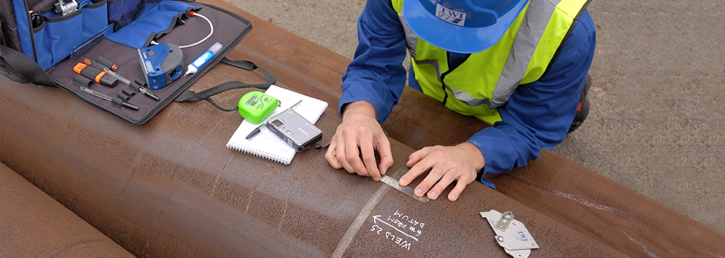Recognizing the Value of Welding Inspection Madison in Building
Recognizing the Value of Welding Inspection Madison in Building
Blog Article
The Relevance of Thorough Welding Evaluation in Industrial Applications
In the realm of industrial applications, the value of meticulous welding assessment can not be overstated. As we check out the complex advantages of persistent welding examinations, one have to think about the broader implications on safety and security, reliability, and cost-effectiveness in industrial procedures.
Enhancing Structural Stability
When it comes to welding evaluation in industrial applications, boosting architectural stability is critical. The primary objective of welding assessment is to make sure that the welds are qualified of birthing the expected stress and anxieties and lots they will come across in solution.
The value of keeping architectural honesty in bonded structures can not be overemphasized. Inadequately implemented welds can bring about disastrous failings, leading to costly repair work, downtime, and also endangerment of human lives. As a result, examiners play a vital role in the lifecycle of commercial elements, providing guarantee that the welding procedure provides the desired strength and toughness.
Moreover, advanced modern technologies, such as phased range ultrasonic screening and digital radiography, deal enhanced abilities in spotting potential weaknesses, allowing for corrective actions prior to problems escalate. By focusing on the stability of welds through careful evaluation, industries can ensure operational performance and expand the longevity of their infrastructure.
Determining Welding Issues
Identifying welding problems is a crucial facet of ensuring the safety and security and dependability of welded frameworks. Typical welding issues consist of porosity, fractures, insufficient combination, and undercutting.

Proficient inspectors make use of both aesthetic examination and advanced non-destructive screening (NDT) methods, such as radiographic or ultrasonic testing, to discover these defects. The prompt identification and rectification of welding defects are important to maintain the structural integrity and durability of industrial components.
Ensuring Conformity Criteria
Compliance with well-known criteria, such as those supplied by the American Welding Culture (AWS) and the International Organization for Standardization (ISO), makes certain that welds satisfy minimum safety and security and high quality requirements. These requirements encompass a broad variety of requirements, consisting of product requirements, welding treatments, and certification of welders.
Normal audits and inspections are necessary in verifying conformity. Assessors must possess a comprehensive understanding of the appropriate requirements and be experienced at using various non-destructive testing (NDT) approaches to evaluate weld quality. By making certain that welding methods straighten with conformity requirements, companies mitigate the threat of non-conformity, which can bring about legal liabilities and safety and security risks.
In addition, maintaining compliance not just safeguards architectural stability however additionally boosts a firm's credibility in the industry. Customers and stakeholders are most likely to depend on companies that continually show a commitment to top quality and safety through strenuous compliance. Therefore, making certain compliance standards is an essential part in the successful implementation of welding in industrial applications.
Decreasing Maintenance Costs

The application of sophisticated non-destructive screening (NDT) methods, including ultrasonic, radiographic, and magnetic fragment assessments, improves the capability to discover subsurface defects without endangering the architectural honesty of parts. By using these strategies, find more sectors can considerably extend the life span of their equipment, minimizing downtime and the connected economic worry of maintenance activities.
In addition, a robust welding examination regime supports the optimization of maintenance timetables, moving from responsive to anticipating maintenance methods. This proactive method not just cuts unanticipated failures yet also improves source appropriation, guaranteeing that upkeep initiatives are concentrated and efficient. Ultimately, the financial investment in strenuous welding assessment is countered by the considerable savings realized with decreased maintenance demands, contributing favorably to the total functional efficiency of industrial enterprises.
Improving Security Actions
Welding inspection plays a vital function in this context, as it guarantees that all joints and connections meet rigid security site here standards. Comprehensive inspections assist recognize problems such as splits, porosity, or incomplete combination that can compromise structural stability.
Approaches like ultrasonic testing, radiographic testing, and magnetic bit inspection allow for in-depth examination without damaging the structure. Carrying out a durable quality control system that includes routine training for welders and assessors ensures adherence to developed safety and security standards.
Finally, cultivating a culture of safety and security within the company emphasizes the significance of extensive welding inspections. Motivating open interaction and partnership amongst welders, inspectors, and engineers contributes to a shared commitment to safety and security quality. Welding Inspection Madison. In doing so, sectors can guard their operations, shield personnel, and maintain public trust

Final Thought
Thorough welding inspection is essential in commercial applications, dramatically boosting structural integrity and integrity. By using sophisticated non-destructive testing methods, possible welding flaws such as fractures and incomplete fusion are identified early, ensuring conformity with sector requirements and promoting client trust. Rigorous inspections lead to lowered upkeep prices and add to a much safer working atmosphere. Eventually, the attentive implementation of welding assessments plays an important function in preserving operational efficiency and safety in commercial setups.
As we discover the diverse benefits of attentive welding evaluations, one must take into consideration the wider ramifications on safety and security, dependability, and cost-effectiveness in commercial procedures.
The main objective of welding evaluation is to make certain that the welds are capable of birthing the expected stresses and tons they will certainly experience in solution. Efficient welding assessment plays an informative post essential function in minimizing these expenses by making sure the integrity and durability of welds, therefore mitigating the risk of premature failings.Comprehensive welding examination is essential in commercial applications, significantly enhancing structural integrity and reliability. Ultimately, the persistent execution of welding evaluations plays an important function in preserving operational effectiveness and security in industrial settings.
Report this page